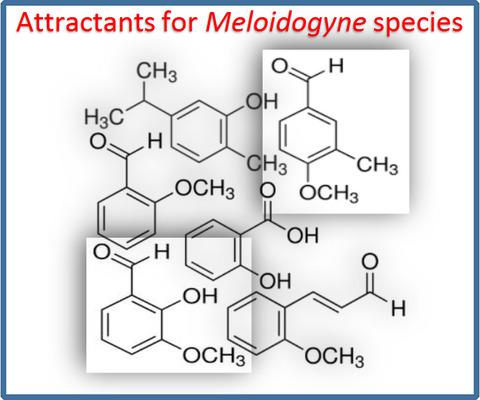当前位置:
X-MOL 学术
›
Plant Pathol.
›
论文详情
Our official English website, www.x-mol.net, welcomes your feedback! (Note: you will need to create a separate account there.)
Screening of chemical attractants for second‐stage juveniles of Meloidogyne species on agar plates
Plant Pathology ( IF 2.7 ) Pub Date : 2020-12-28 , DOI: 10.1111/ppa.13336 Yuji Oka 1
Plant Pathology ( IF 2.7 ) Pub Date : 2020-12-28 , DOI: 10.1111/ppa.13336 Yuji Oka 1
Affiliation

|
The attractiveness of 60 aromatic compounds, mainly carboxylic acids, alcohols, aldehydes, and phenols, to second‐stage juveniles (J2) of four Meloidogyne species (M. hapla, M. incognita, M. javanica, and M. marylandi) was evaluated based on the relative density of J2 attracted to a test compound on an agar plate in an 8.5‐cm Petri dish. Three types of nematode responses were observed in the single‐compound assays: attraction, in which J2 were attracted to test compounds; concentration‐dependent attraction, in which J2 were attracted to the zone located 1–2 cm from test compounds; and no response. None of the test compounds effectively attracted M. incognita or repelled J2 of any species. Thirty‐five compounds attracted J2 of at least one of the other three nematode species. Highly effective attractants were trans‐cinnamic acid, salicylic acid, 4′‐hydroxy‐3′‐methoxyacetophenone, o‐vanillin, carvacrol, 3‐methoxybenzyl alcohol, 2‐methoxycinnamaldehyde, trans‐p‐methoxycinnamaldehyde, 4‐methoxy‐3‐methylbenzaldehyde, 2‐methoxy‐4‐propenylphenol, and thymol. Salicylic acid dissolved in the agar reduced the attraction of M. marylandi J2 to salicylic acid and to o‐vanillin. Two‐ and three‐compound assays revealed differences in attractiveness to M. marylandi J2 between or among structural isomers of the attractants. o‐Vanillin and salicylic acid were much more attractive to M. marylandi than vanillin and the two isomers of salicylic acid, respectively. It is not clear whether nematodes utilize the attractants found in the study for locating hosts in nature, but the attractants may have potential for use in nematode control.
中文翻译:

在琼脂平板上筛选Meganogyne菌种的第二阶段幼体的化学引诱剂
评估了60种芳香族化合物(主要是羧酸,醇,醛和酚)对四种Meloidogyne种类(M. hapla,M。incognita,M。javanica和M. marylandi)的第二阶段幼体(J2)的吸引力。根据在8.5 cm培养皿中的琼脂平板上被试验化合物吸引的J2的相对密度确定。在单化合物测定中观察到三种类型的线虫反应:吸引力,其中J2被测试化合物所吸引;浓度依赖性吸引,其中J2被吸引到距测试化合物1-2 cm的区域;却没有回应。没有一种测试化合物能有效地吸引隐孢子虫或排斥任何物种的J2。35种化合物吸引了其他三种线虫物种中至少一种的J2。高效引诱剂为反式肉桂酸,水杨酸,4'-羟基-3'-甲氧基苯乙酮,邻香兰素,香芹酚,3-甲氧基苄醇,2-甲氧基肉桂醛,反式-对甲氧基肉桂醛,4-甲氧基-3-甲基苯甲醛,2-甲氧基-4-丙烯基苯酚和百里酚。溶解在琼脂水杨酸的吸引力降低M. marylandi J2水杨酸和Ò -vanillin。两种和三种化合物的测定揭示了引诱剂的结构异构体之间或之间对玛丽兰分枝杆菌J2的吸引力存在差异。Ø-Vanillin和水杨酸是多少更具吸引力M. marylandi比香草醛和水杨酸的两种异构体,分别。尚不清楚线虫是否利用研究中发现的引诱剂来定位自然界中的宿主,但是引诱剂可能具有控制线虫的潜力。
更新日期:2020-12-28
中文翻译:

在琼脂平板上筛选Meganogyne菌种的第二阶段幼体的化学引诱剂
评估了60种芳香族化合物(主要是羧酸,醇,醛和酚)对四种Meloidogyne种类(M. hapla,M。incognita,M。javanica和M. marylandi)的第二阶段幼体(J2)的吸引力。根据在8.5 cm培养皿中的琼脂平板上被试验化合物吸引的J2的相对密度确定。在单化合物测定中观察到三种类型的线虫反应:吸引力,其中J2被测试化合物所吸引;浓度依赖性吸引,其中J2被吸引到距测试化合物1-2 cm的区域;却没有回应。没有一种测试化合物能有效地吸引隐孢子虫或排斥任何物种的J2。35种化合物吸引了其他三种线虫物种中至少一种的J2。高效引诱剂为反式肉桂酸,水杨酸,4'-羟基-3'-甲氧基苯乙酮,邻香兰素,香芹酚,3-甲氧基苄醇,2-甲氧基肉桂醛,反式-对甲氧基肉桂醛,4-甲氧基-3-甲基苯甲醛,2-甲氧基-4-丙烯基苯酚和百里酚。溶解在琼脂水杨酸的吸引力降低M. marylandi J2水杨酸和Ò -vanillin。两种和三种化合物的测定揭示了引诱剂的结构异构体之间或之间对玛丽兰分枝杆菌J2的吸引力存在差异。Ø-Vanillin和水杨酸是多少更具吸引力M. marylandi比香草醛和水杨酸的两种异构体,分别。尚不清楚线虫是否利用研究中发现的引诱剂来定位自然界中的宿主,但是引诱剂可能具有控制线虫的潜力。



























 京公网安备 11010802027423号
京公网安备 11010802027423号